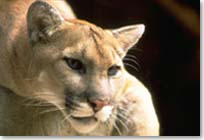How a Puma Purrs
Those of you who love your pet cats know what happens when you softly stroke their fur or rub their ears. Purrrrrr. But did you know that domestic tabbies aren't the only cats that purr?
On an extremely rare occasion, a mountain lion or a bobcat might still be spotted by a visitor in one of our county parks. Both these wild felines can make a variety of household cat sounds. Baby mountain lions (also called pumas and cougars in different parts of the country) and baby bobcats meow like household kittens. As adults, they growl, hiss and spit when they are displeased. When they are contented, they purr.
Of course a full-grown mountain lion purrs about twenty times louder than that friendly puss who sleeps most of the afternoon at the foot of your bed. Not all kinds of cats can purr. Cats that can roar -- such as tigers, jaguars and African lions -- can not purr. And cats that can purr --such as cougars, bobcats and household tabbies -- cannot roar. Until recently, exactly how purring cats managed to purr was a mystery. If you try to purr continuously like a mountain lion or bobcat, you'll quickly discover its impossible for you to do.
When you caress your pet cat, the animal seems to vibrate all over. Scientists first thought that cats might possess a special "purring organ." But none has been found. Then by pressing a microphone against different places on a happy cat's body, researchers discovered that the greatest vibrations originated at the cat's throat, right over its larynx, commonly called the voice box. They correctly guessed that the purring must be coming from the cat's voice box. But then, why can't we purr? After all, human beings have voice boxes too.
More research finally uncovered the answer. The puma, bobcat and your pet puss possess something you don't. Inside each of these cats' brains is a special timer.
This timer can send rhythmic nerve messages -- at 25 electrical pulses per second -- to a particular muscle in the cat's voice box. With the first pulse from the brain's timer, the muscle swings the vocal folds in the larynx together. It almost closes off the air passage through the voice box. With the next pulse, the muscle relaxes. The airway again opens. These opening and closing folds change the airflow through the cat's voice box. The airflow is usually steady as the mountain lion or bobcat inhales and exhales. When the timer's working this steady stream turns into a putt-putt-putt of air through the larynx. What does this putt putt putt sound like? Purrrrrr.
